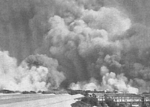SS Fort Stikine
1942 ships1944 in IndiaAC with 0 elementsHistory of MumbaiMaritime incidents in April 1944 ... and 3 more
Ministry of War Transport shipsShips built in British ColumbiaUse British English from January 2017

Fort Stikine was a British Fort ship which was built in Canada in 1942. Owned by the American War Shipping Administration, she was leased under charter to the Ministry of War Transport under the Lend-Lease scheme and operated under the management of the Port Line. Fort Stikine only had a short career, and was destroyed in an explosion at Bombay, India, in April 1944 that caused the loss of a further thirteen ships.
Excerpt from the Wikipedia article SS Fort Stikine (License: CC BY-SA 3.0, Authors, Images).SS Fort Stikine
Angriya Water Terminal, Mumbai Wadi Bandar (Zone 1)
Geographical coordinates (GPS) Address Nearby Places Show on map
Geographical coordinates (GPS)
| Latitude | Longitude |
|---|---|
| N 18.9528 ° | E 72.845 ° |
Address
Angriya Water Terminal
Angriya Water Terminal
400001 Mumbai, Wadi Bandar (Zone 1)
Maharashtra, India
Open on Google Maps








